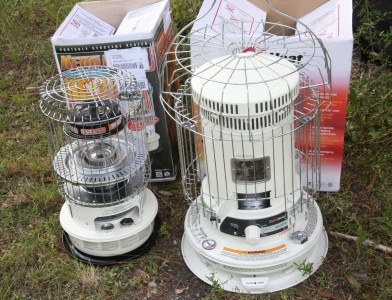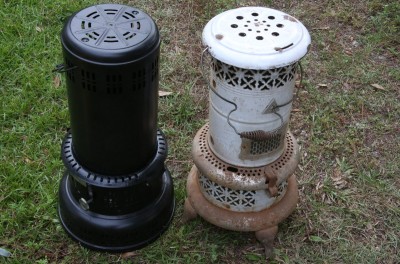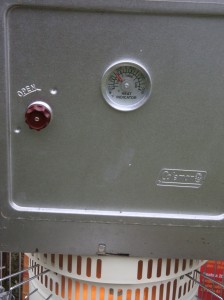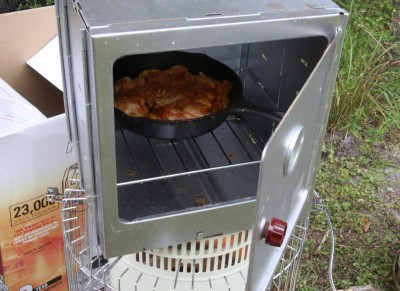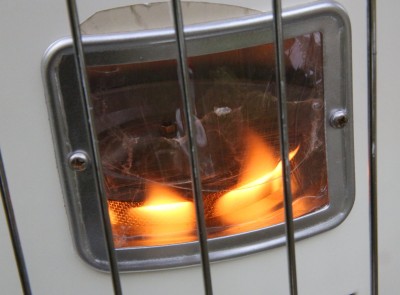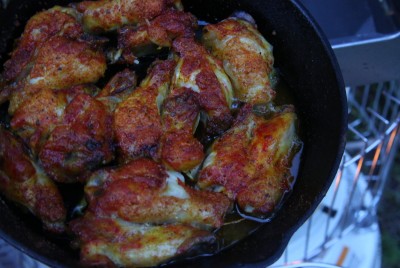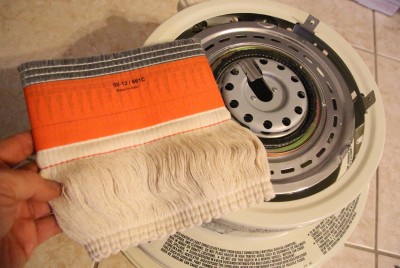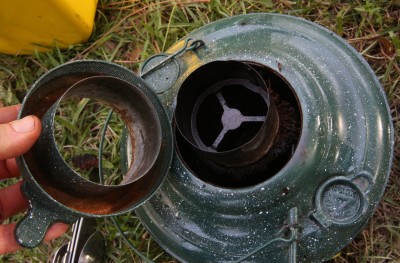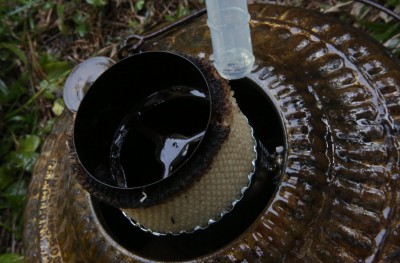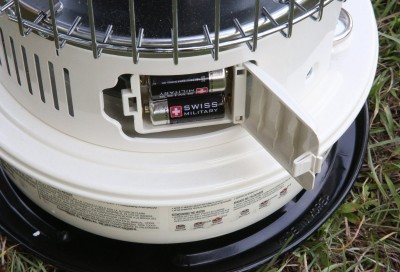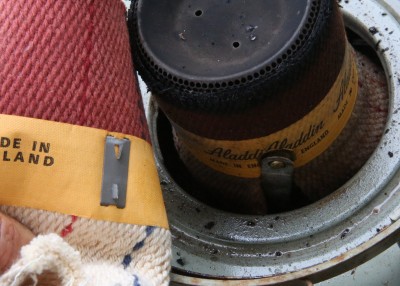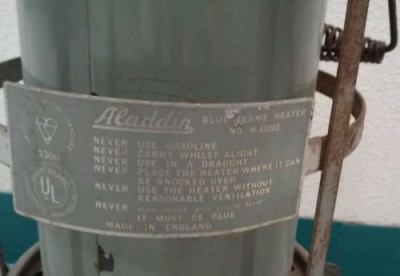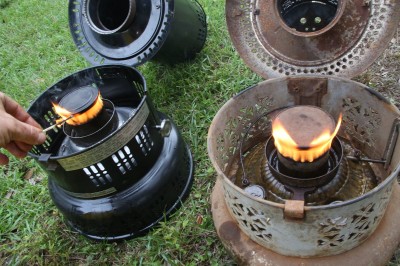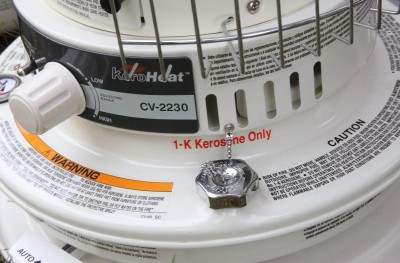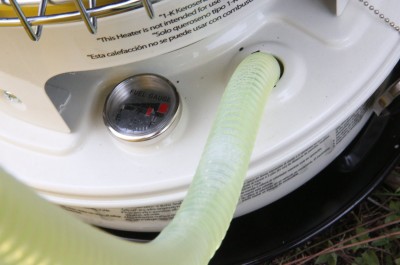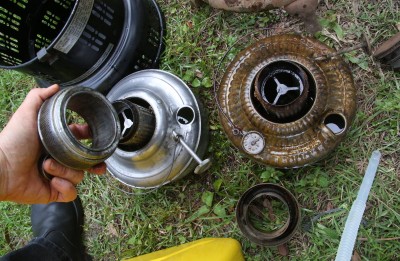
If you heat with home heating oil, there is an efficient to utilize the fuel in your tank for survival. New production kerosene heaters are not terribly expensive, and they can deliver up to 23,000 BTUs of heat.
Resources:
Kero-World Heaters at Kerosene-Wicks.com
Kero-World Heaters on Ebay
Perfection Heaters
Aladdin Heaters
Replacement Wicks at Kerosene-Wicks.com
All American Pressure Canner at Red Hill
Pressure Canners at Lehmans
Tegmart Devil Watt Thermoelectric Generator
My research of late has taken me back to the subject of heating for the winter. About this time last year I reviewed the US Military H-45 stove, which burns diesel and gasoline, and at full tilt, it is a bit much of a stove to handle, and it consumes a good deal of fuel. If you already burn home heating oil to heat your house in the winter, it is an emergency heater you should take a look at. But for long term survival, where every ounce of fuel counts, there are some better options.
If you don’t burn home heating oil for your home, most likely you rely on natural gas. Some people have their own gas wells, which is fantastic, but if you are on city natural gas, it is probably a good idea to have a backup plan that can last you through at least a winter. Storing diesel fuel is a lot less scary than storing gasoline, because it will not ignite without a wick, and diesel produces no flammable gas like gasoline. For this article I am taking a look at a few different kerosene space heaters, burning diesel, which is now down to just over $2 per gallon. These space heaters are meant for indoor use, and they use a lot less fuel than the H-45. All of these heaters lit easily and ran reliably with diesel, and I was also able to can some veggies with a pressure canner on top of one of them. If you have been putting off a solution for post disaster winter heating, these stoves are not that much money, and they won’t fail you.
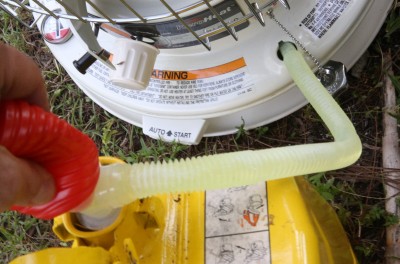
I tested these heaters with diesel fuel. Chemically it seems to be interchangeable with kerosene, and I don’t find it to be any more smelly. At $2.26 a gallon locally, diesel is the most stable and inexpensive fuel you can buy at this point.
You may be wondering why you can’t just adapt your existing oil burner to off-grid, and of course you can. But home heating oil, without some sort of wick, requires that it be heated before it will aerosolize and burn in open air. Therefore your oil burner has an electric heater in it, as well as a fuel pump, and it requires a significant amount of electricity. I haven’t dug into the research as to how many amps the average oil burner consumes, but since a heater is involved, it is probably outside the bounds of low cost solar, especially in grey winter skies. You would have to run a fuel burning generator to burn your home heating fuel, and that is horribly inefficient. A full home heating system also heats the whole house, whether you need the whole house or not.
You can see from the pictures that these heaters are made for 1-K kerosene, not diesel. From my research, there is very little if any difference in the two, and these days it is nearly impossible to get actual clear kerosene for less than $10 per gallon. Even the kerosene that is available out there, that has a red dye in it, is over $5 per gallon, and the red dye has been known to clog wicks.
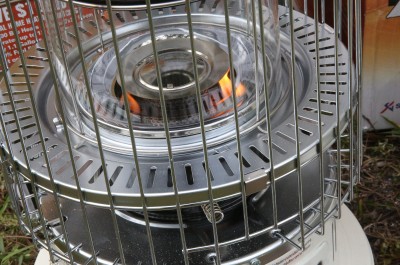
I didn’t compare these heaters with kerosene, but this is the smaller Kero-World heater just getting going with diesel. After the wick was soaked, it took about 5 minutes for the flow to reach steady.
Proving that diesel is essentially kerosene is not an easy task. There are a number of names for kerosene worldwide, and in some countries kerosene and diesel are used interchangeably. Kerosene is also called paraffin, so it gets really confusing, because some products, like Aladdin lamps, specifically say don’t use paraffin. Add to that a lot of obfuscation in the camping equipment world about what fuels can be used in various stoves, cookers and heaters. You can go around and around as you’ll see some people suggest paraffin for certain things, kerosene for others, and diesel, jet fuel, and home heating oil interchangeably with all of the above. So I looked at the Wikipedia page for Fuel Oil. It seems that the diesel is an alias for the same fuel as kerosene, which in practice, for many years, has been my understanding. The Kerosene Page explains that “Heat of combustion of kerosene is similar to that of diesel; its lower heating value is 43.1 MJ/kg (around 18,500 Btu/lb), and its higher heating value is 46.2 MJ/kg.” It also says that “JP-8, (for “Jet Propellant 8″) a kerosene-based fuel, is used by the US military as a replacement in diesel fueled vehicles and for powering aircraft. JP-8 is also by the U.S. military and its NATO allies as a fuel for heaters, stoves, tanks and as a replacement for diesel fuel in the engines of nearly all tactical ground vehicles and electrical generators.”
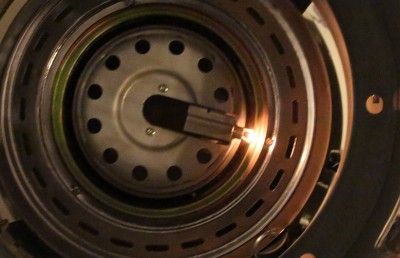
I was able to light the larger heater with the electronic ignition after installing the batteries, but the small one preferred a match. I did not however let this sit with fuel for an hour as is instructed in the directions. I suspect it would have gone better.
In general it seems that kerosene, jet fuel and diesel are somewhat interchangeable, and that diesel certainly poses no hazards that you would find with gasoline or Coleman Fuel/white gas, used in a similar manner. That said, my tests here are for my benefit, and I am not suggesting that you do anything with the stoves here besides follow the manufacturer directions. This is a research article, not an instructional article.
The complaints you will hear about running diesel in these stoves is mostly the smell, but I don’t find it any different than kerosene. The Kero-World manuals say that “fuels other than kerosene” can contain sulfur, and lead to a rotten egg smell. I’m not sure this is true in the US diesel right now, because I have had no hint of it whatsoever.
Otherwise, the kerosene/diesel burning smell really bothers some people. My wife can’t even take being in the same room with an oil lamp with a 1/2″ wick, because the smell gives her a headache. I just worked with 5 of these stoves all day, with the fumes in my face (in the Florida heat) and I love the smell. It smells like camping lol. Diesel doesn’t light quite as easily as kerosene, but I find that if you wet the wick directly with the diesel, then let it soak in the fuel for a while, it lights fine with a match. The new production stoves you see here have electronic glow igniters, and they didn’t work great, but it was probably just because I didn’t let them sit for an hour with fuel in them as it suggests in the instructions, which I read later. You don’t have to use the igniter if the batteries die regardless. A match works fine.
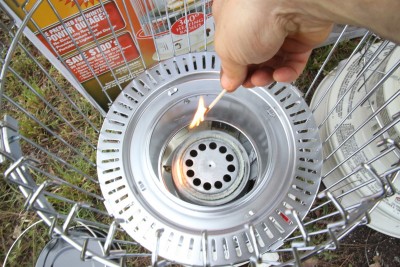
As complicated as the newer heaters may look, they are no more complicated than the 100 year old Perfection heaters. A wick is a wick is a wick.
As you can see from the pictures, I tested 5 different stoves. Two of them are new, made by the Kero-Heat company, or Sengoku, depending on what labeling you get. The come in the 23,000 BTU size which is the larger one here, and the 10,500 BTU smaller version here as well, plus a square 10,000 BTU version I didn’t test. The big one at full retail is $149, and it is rare that you will beat that price when shipping is included. Spare wicks are available for about $12 each. The smaller new caged heater is tough to find cheaper than $130 or so including shipping. Since you can turn down the larger one, I would just get that. Demand is so high for them right now that winter has arrived, don’t expect a deal. I got one a little cheaper than it should have gone, but it came with a broken mica window and no manual. The manual can be found in PDF online.
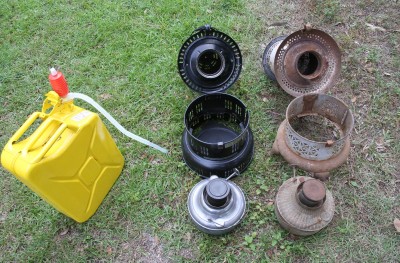
The Perfection heaters seem to be all the same. They are just a steel frame that holds this tank and burner assembly.
I also reviewed a few older kerosene heaters because I know that so many readers of this column are on tight prepping budgets. But surprisingly, the old heaters don’t go for cheap on the used market. Even rusty and beat up they are somewhat collectible, and because replacement wicks are still readily available, people in the know value their simplicity and bulletproof reliability. I am including them here in case you have seen one at a local junk shop that you can buy at a discount from what you would find online, or if you are also so inclined toward simplicity.
Also note that from what I have researched thus far, the H-45 is the only option for kerosene/diesel that does not require a wick. With that heater you thrown in a ball of paper to light as a temporary wick, then the heat of the can aerosolizes the diesel and sucks it through the system. I am working on a separate article right now on kerosene cookers, and those are split into two categories, those with a wick and those without a wick. With heaters, wicks are pretty much universal, except for that one military stove. Diesel reportedly clogs the wicks on some of these heaters after a few burns, though I have only seen evidence of that through anecdotal stories. Is it just fiberglass wicks? Cotton wicks? The H-45 is a no-wick option that at least removes that variable.
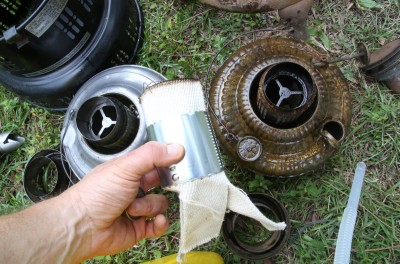
After dousing the burners with some fuel, the wicks came right out and the raising mechanisms worked fine. This is a new Perfection 500 wick, readily available online.
Of the wick heater stoves, there are very few actual designs, despite the different names they were produced under. The “Perfection” heater is probably the most common. You can usually find about a dozen for sale on Ebay at any given time under the Perfection name, and in decent shape they’ll go for $100, which is what I paid for the black one you see here. The white one I got is all rusted and was just under $100 with shipping, and it still words fine. Occasionally you’ll find a Perfection from an estate sale that was bought as an emergency backup and never used, but they sell generally for over $200. If you look around and just search for “kerosene heater,” you’ll see the exact same design under many other names, usually a little cheaper. I didn’t experiment with ordering these in hopes that they would take the same wick.
Wicks for all of these heaters, old and new, are cheapest I have found at the Red Hill General Store. They have a specific site I have linked above, called Kerosene-Wicks.com, and they also sell the Kero-World heaters. The new large heater takes a fiberglass wick. The smaller one seems to be either cotton like the older heaters, or it is a fluffier fiberglass.
The Kero-World heaters both came with the wicks installed, and I was able to install new wicks in both designs of these Perfection heaters and fire them up with no problems at all. I have included pictures so you can see all the parts required for a complete unit, thereby you can ask the seller to test the wick raiser. Don’t be scared away by surface rust, even on the removable tank and burner assembly. The white heater you see here was covered in rust and probably hadn’t been used for over 50 years, if not 100, but I soaked the rusted parts in diesel for a bit, after which it worked fine. Not every single one you find will work well. I bought a separate just tank/burner also on Ebay, with no heater shell, and the wick is pretty stuck to the cylinder that holds it, and it will require work to get it back to working order. If you decide to buy a Perfection, just read the description and ask the seller if the wick will raise and lower without being lubricated. If it won’t, it still may be worth making a cheap offer in hopes that a little bit of fuel will loosen it. The mechanism itself is very simple. The downside to the old stoves is that they have no fuel gauge or automatic shutoff.
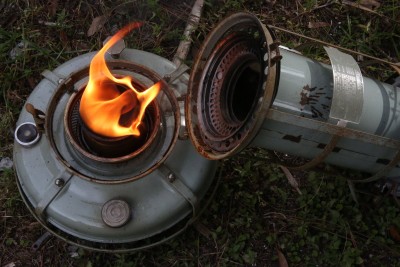
The other heater I reviewed is the Aladdin Blue Flame. This one was made in England, and came with a new wick in it.
The other old heater is the Aladdin Blue Flame. They sell for as much as $200 online in the condition you see here, because of the collectible name brand. In pristine, unused estate condition I have seen them sell for into the $400s. The Blue Flame has been a favorite in icefishing shanties for generations, and like the Perfection, it is fairly simple to use. The Blue Flame was made in England, and I’ve also seen some made in Iran, and supposedly some came from Germany. Keep that in mind as you research what you will pay for utility vs. the collectability of them. There are a number of different model names, and there even Blue Flame heaters that came with a grate on top for cooking. Be patient if you are shopping for one of these heaters. Using the pictures here you should be able to recognize all of the parts, so you may be able to snatch one that the seller advertises as “may not be complete” but is complete. Just make sure the wick riser works. Aladdin has made many many other stoves under many many model names over the years, but the Blue Flame are the most popular and collectible.
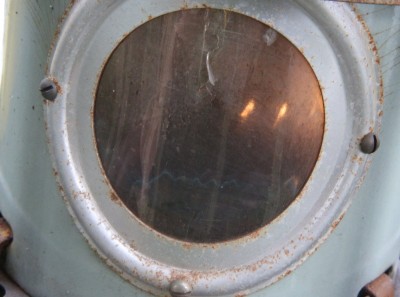
The Blue Flame burns the carbon monoxide, and it does have a blue flame. I was unable to get all of the yellow flame out, because my wick was uneven.
The burner assembly on the Blue Flame is lot like the Perfection, but it doesn’t lift out. It also doesn’t have a cap that sits on top of the wick. Aladdin figured out a stationary central cap design that when choked down with a thin tube of air using a center draft point, will burn the carbon monoxide from the flame, which results in a blue flame, and one that smells less and is 100% safe to use in a small space (like an icefishing shanty). I was only moderately successful getting the blue flame, because I hadn’t yet gotten the Aladdin Wick Cleaner, which goes for just over $20 with shipping. It is just a disc that fits over the wick and evens it. My wick that came with the Blue Flame you see here was almost new, but not of even height all the way around, so there were yellow flames on the long edge. The heater specifically says don’t allow yellow flames, so I ordered the wick cleaner.
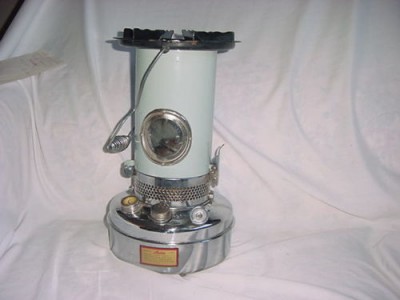
There are many different models of Blue Flame. This one, with a cooking grate, just sold on Ebay the other day.
The wick raiser on the Blue Flame is not what I would call as robust as the Perfection. Since my wick was new, I didn’t need to replace it with the replacement I got online, which is good because I got the wrong one. My model is called the J280, and the wick on the heater has two buttons that ride inside holes in the wick carrier. My replacement wick has hooks, which come from a different model Blue Flame but that I can probably adapt to this model. Overall my impression is that the Aladdin is probably the cream of the crop when it comes to a kerosene heater, but like every perfected system, it is a little cantankerous and likes to get its way.
Fuel Pumps and Storage
Can you imagine freezing to death when you have a full tank of fuel in your basement? I am sure that in the Northeast, that will be the case after the grid goes down. Most people have no concept of how their oil burner works, nor do they have the ability to get the oil out of the tank. A can opener won’t work. You need to buy at least a length of fuel-safe hose so you can mouth siphon it. I strongly suggest against this, and I would instead get at the very least a cheap liquid transfer pump. They can be found for about ten bucks online, but you should get a longer takeup hose that reaches the bottom of your fuel tank. You can also make your own with a squeeze ball and hose. The important thing is to just do it.
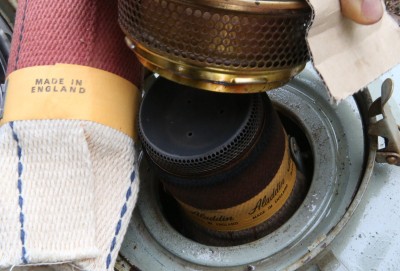
The only removable parts on the Aladdin are the burner ring and that cap in the middle. The wick pushes down over the center draft cylinder, like the Perfection.
I used to live in the Northeast where fuel oil heating is nearly ubiquitous. Most of those systems contain a hot water heater, so most people don’t let their fuel sit from season to season. At some point the water heater on our system broke and we would have had to replace the whole burner (out of budget), so I installed an electric hot water heater. That meant that our oil burner would lie dormant for at least 5 months per year. I never took any precautions for preserving our fuel, but I have since learned that diesel fuel, home heating oil and kerosene suck water out of the air, and that can lead to mold and fungus clouding your fuel. Jet fuel, which is 1-K kerosene, has anti-fungals added to it, and you can do this same thing with Pri-D Fuel additive found on Amazon. It is more expensive than the Walmart fuel additives, but I think it is worth it.
Cooking, Canning, Charging Your Phone
Whenever generating heat is involved, I always think about what could be done at the same time. These stoves are not monsters. You do need a handle to carry them, but there is no blast of heat, like the H-45 stove, which actually creaks as it gets hot and will scare the daylights out of you the first few times you run it. I didn’t think to try cooking and canning on the H-45 when I tested it a year ago, so I have been thinking about breaking it out again. Since I live in South Florida, none of these heaters are really relevant to my life, so call me selfish, I have moved on.
For this kerosene wick heater article I decided to try cooking some chicken in my little Coleman camp oven, and after confirming that water will boil even on the smaller heaters, I tried to can some vegetables. As you can see from the pictures, both experiments worked perfectly, though at varying levels. The large 23,000 BTU heater maintained an average temp in the tiny oven of 275-300 degrees, fine to cook bread, meat, whatever.
The canning also worked, but I didn’t monitor the process. It is slow going, and I got bored waiting for the canner to heat up, so I went out to the 7pm movie. Then, lo and behold, they were doing a preview showing of the last Hunger Games movie at 9:30, so I stayed for two movies and got home at midnight. I had started the heater with about a half a tank of fuel at 2pm, so when I got back, the stove had quit, the canner was cooling, and I went to bed. In the morning I opened the canner and the 1/2 gallon glass jars of beets and carrots were sealed, with the pressure buttons sucked in, so I did something right. You aren’t even supposed to do 1/2 gallon jars with low acid foods, but I always have and they last fine. But as always, these are just my experiments I am not giving advice.
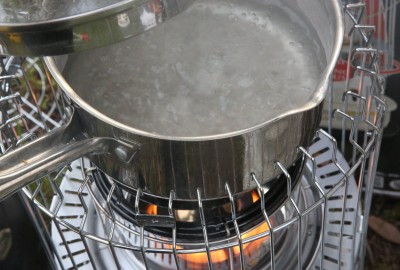
The smaller heaters held the oven at just over 200 degrees, so I was correct in assuming they would boil water. This is the 10,500 BTU Kero-World.
My take is that canning will be a huge benefit after the collapse. If there is still farming, and their may very well be, farmers have always had the problem of too much food at one time. Your own garden will show you this quickly as well, especially if you grow zucchini. That is why we have a money system, so you can get some zucchini when the farmer has way too much, but you don’t have anything specifically that the farmer needs right now. You pay him money, which he can store and use to buy what he wants, because everyone recognizes the same value of the same money. But when the money collapses (and it has to at some point in the near future), the farmer is only going to swap for things of value. That may be silver and gold, but it also may be a sewing machine, a guitar for his son, or, you guessed it, an Aladdin Blue Flame heater and some extra wicks.
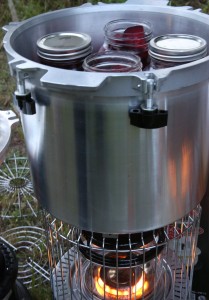
So I decided to try some canning. I just happened to fall upon some cheap beets and carrots in bulk, and I’m trying to not leave my canning jars empty in storage.
However I don’t think there is going to be a lot of commerce for 3 beets and 3 carrots, because you lack refrigeration and can’t eat more than that right now. At least initially, I think the deal will be for a case of beets, or 20 cases of beets. In order to live off of deals like this, you’ll need to be able to can food. I have I am no newcomer to it. The information you can find online these days is more vast than any of us could have imagined back when this whole party began, and from a survival perspective, there just aren’t enough hours in the day to learn everything. There are experts on every single one of these topics online somewhere, and as a prepper you need to become a true jack of all trades. I didn’t know anything about aerosolized and wicked diesel fuel two weeks ago, even though I bought and physically tested the H-45 stove a year ago. I thought I knew a lot about Russian gas masks until I researched the back story on them online, and cut a filter open.
My approach is to learn only as much as I need to in order to move on to the next thing. Now I have fully experimented with wick heaters, and after SHOT when I return to this column we will be looking at kerosene cookers as well as Aladdin and other center draft lamps, using of course, diesel.
I mention this because of the sometimes nasty back and forths we get on the comments here on these articles. Oftentimes, the commentators are experts in that particular field, but they only clicked on the article because they wanted to see if it matched up with what they “know.” Otherwise, they are not people who are focused on the coming collapse, and they are not people who are going to survive when this charade we live in ends. Sometimes they have some great advice, in a best case scenario environment, not survival, and our focus here is purely on long term survival after a system collapse.
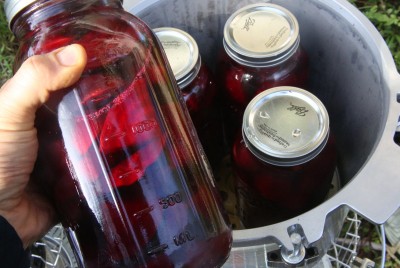
I have to admit that I was lax in monitoring the process after the canner got up to steam temp. But hey, it worked. When I got home from the movies at midnight the stove was out of fuel and the canner was cooling. In the morning, the jars were perfect.
Sometimes the people leaving the comments are just armchair fools trying to make themselves feel good. One of the downsides of the internet is that it has given a loud voice to people who have not earned it. It may seem that I am vicious at times in responding to comments, but I only beat up people who are clearly adding nothing of value, for whatever reasons. Sometimes these comments are just nonsense. Sometimes plain lying. I spend as much as 30 hours and $2,000 on some of these articles. My experiences are extremely valuable, and I have yet to find a prepping and survival site or magazine that has comparable, tested information. A few months ago I actually bought a news stand large format survival magazine, and it actually had a feature article on choosing a bug out backpack for children, because Columbia was a major advertiser.
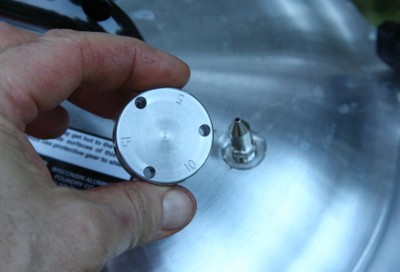
For this experiment I used my All American Canner with the 10 pound setting, once I had bled off the air in the pot. I knew the stove had a couple hours of fuel left, and the canning time for these 1/2 gallon jars is probably over 70 minutes.
So should I just delete the self serving bonehead comments?
I think not, because it gives us all the opportunity to confront the voices in our head (pun intended) that tell us that survival is too complicated, and that we should just do nothing. That is the goal of nearly every one of these comments, to paralyze you into inaction. I think we all should do our best to prepare for what at this point is an inevitable upheaval in our society. The story isn’t the Donald Trump, Isis, theater. It is one of oligarchs perverting the monetary exchange system of the entire world, and a sick experience in Geoengineering that has all but guaranteed the extinction of man within possibly even this generation.
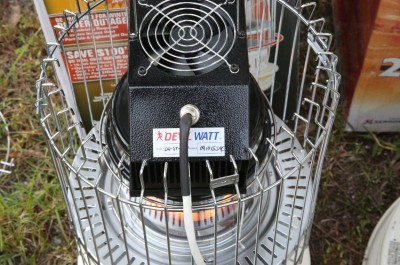
My only failed experiment was the Devil Watt. I couldn’t get it to charge the batteries. The fan never moved. Perhaps the 10 watt requires a lower operating temp.
And as my regular readers know, I’m not writing this column and calling people names in the comments because I think I’m going to survive while less prepared people will for sure die. I think that prepping is about forward thinking, and I come from a history of that, as I’ll explain.
Though I have to admit it does inflate my ego a bit, I linked above to my 1997 book about internet automation to show you that I am somewhat forward thinking. I am writing this article you are reading on an internet automation system called WordPress. It was directly inspired by my book. My “Web Post” system was the first open source free system in the world (to my knowledge) for form based remote content authoring.
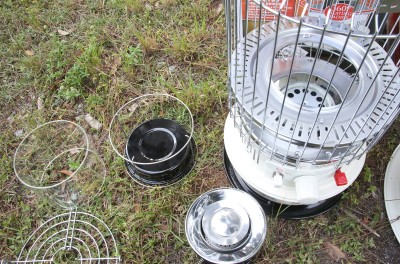
The small Kero-World has a nice glass viewing window, but it is less durable than the larger 23,000 BTU unit which uses a mica window.
Also, my father, Richard Helinski, was one of the initial inventors” of color ink jet printing, and the sole inventor, and patent holder for 3D printing in 1989. All of the 3D printers in universities you see were licensed on my father’s patent, and it is only because that patent expired that 3D printing was able to take off without having to pay royalties.
I am sharing this stuff very deep in the article because I know that only my regular readers will read it. I just want you to go out and do something, rather than just read this column as entertainment. Forward thinking is the only reason any of this matters, and I’m trying to explain that forward thinking is in my blood. Real survival isn’t TV reality theater where you can learn how to equip your underground bunker with a propane flamethrower guard system (yes, I have at least watched the prepper shows once). The only driving motive to learn and do this stuff is to envision yourself after the lights go out. Click. No more supermarket. No more refrigerator. No more city water. No more cell phones. No more internet. And for this article, no more oil burner.
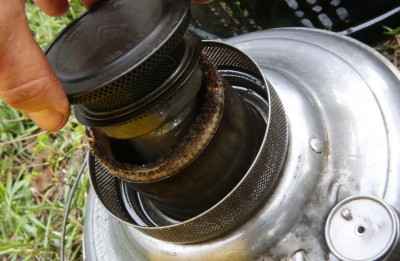
The Perfection components are of course the outside shell, which controls the draft, and the burner and tank assembly. This cap rides on the outside of the wick, and the ring you see here is the only other piece you need to make sure you have.
Is Anyone Safe for the Winter?
From what I have researched, those of you on natural gas will have it a little easier, because the natural gas systems themselves run on natural gas. But what if part of what’s coming is some kind of revolution, and the infrastructure is intentionally destroyed by one side or the other? When everything adds up to bad, you have to forward think yourself into a world with no outside resources. Do you want to say damn it I should have taken this seriously when I could have?
So egos aside, if I beat up comments here, it is because I want us to all learn something from this process, but not to the point of paralysis. Sure, there are experts on collecting and storing rainwater, and lots of specialty equipment, which I am going to eventually get to, but at the end of the day, for pure survival, you need gutters and a cistern. Sure, you can spend $200 on a gas mask, but a $20 Russian mask will give you a few hours to flee if your radiation detector tells you that fallout is going to kill you. For this article, to use your 200 gallons sitting there of home heating oil, you need a wick heater and a pump to get the oil out of the tank.
Good advice here in the comments, like how to trim or clean wicks, is always welcome. And hopefully we are all the better off for it. I hope there is a happy ending here, and I’d like my kids to live to see it. You and your kids too.
